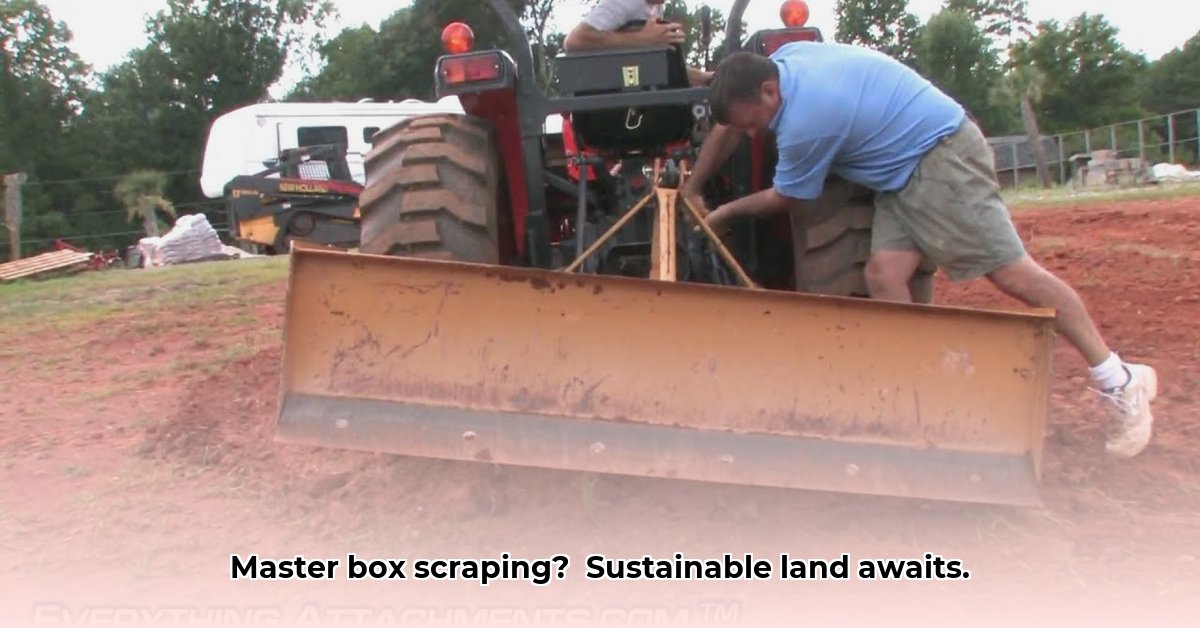
How to Use a Box Scraper on a Tractor: A Comprehensive Guide
A box scraper is a versatile attachment for your tractor, capable of transforming land management practices for greater efficiency and sustainability. This guide will equip you with the knowledge and skills to use a box scraper effectively and safely, improving soil health and optimizing your land's potential. We'll cover everything from basic safety procedures to advanced techniques. For more on land leveling, see this helpful guide on leveling land.
Safety First: Prioritizing Your Well-being
Before even considering attaching the box scraper, prioritize safety. Think of it like pre-flight checks for an airplane – crucial for a successful and damage-free operation.
Appropriate Attire: Protective clothing is non-negotiable. Wear sturdy work boots, long pants, gloves, and eye protection. Consider hearing protection for extended use. This isn't about fashion; it's about safeguarding yourself.
Pre-Operation Inspection: Before starting the tractor, carefully inspect the box scraper and the tractor's three-point hitch. Look for any damage, loose bolts, or worn parts. Addressing minor issues prevents major problems down the line. A careful inspection could prevent a costly repair.
Clear the Area: Ensure the area is free from obstructions – rocks, debris, and importantly, other people. Consider using cones or flags to mark boundaries, especially when working near roads or other areas of traffic.
Visibility and Awareness: Maintain excellent visibility. If operating in low-light conditions or poor visibility, a spotter is highly recommended. Their additional eyes can significantly improve safety.
Know Your Limits: Don't overextend yourself or your equipment. Rest when needed, and never push beyond your comfort level. Safety always trumps speed or ambition.
Understanding Your Box Scraper: Components and Function
The box scraper's effectiveness hinges on understanding its components. It's more than just a blade; it's a system of interconnected parts.
Three-Point Hitch: This system connects the box scraper to your tractor, allowing for easy attachment and adjustment. It's the crucial interface between your tractor and the implement.
Top Link: The top link is adjustable and controls the angle and aggressiveness of the blade. This critical component dictates the effectiveness of various tasks, from light scraping to heavy scarification.
The Blade: Typically made of heavy-duty steel, the blade is designed for tough work. Its durability is key to its effectiveness, but regular inspection is crucial.
Side Scourers (Optional): Wider models often come equipped with side scourers to increase the overall working width of the box blade.
Setting Up the Box Scraper: A Step-by-Step Guide
Attaching the box scraper correctly is crucial for both safety and effectiveness. Follow these steps meticulously:
Raise the Hitch: Use the tractor's three-point hitch controls to fully raise the hitch arms. This allows for easy alignment of the box blade's attachment points.
Connect the Box Scraper: Guide the box scraper's hitch pins into the corresponding slots on your tractor's hitch. Ensure they are secured correctly.
Secure the Top Link: Connect the top link, adjusting its length to control the blade's angle. This adjustment is important for various tasks, like scraping or leveling.
Lower the Blade: Carefully lower the blade using the tractor's three-point hitch controls. Start slowly and make adjustments as needed.
Initial Test: Make a test pass over a small, uncritical area to check for proper alignment and depth of cut.
Different Uses of the Box Scraper: Optimizing for Specific Tasks
The box scraper's versatility lies in its ability to perform various tasks depending on how you adjust the top link and the three-point hitch.
Scraping: For removing thin layers of topsoil or smoothing uneven surfaces, maintain a shallow angle on the top link. Multiple passes may be required for even results.
Leveling: Achieving a perfectly level surface requires patience and finesse. Use a moderate top link angle and let the blade follow the contours of the ground. Utilize the "float" position on your three-point hitch if available.
Scarifying: To break up compacted soil, use a steeper angle on the top link. This aggressive approach is perfect for improving drainage and soil aeration. Expect some resistance and maintain control at lower speeds.
Dragging: For spreading materials like gravel or manure, use a shallow angle and make multiple passes, ensuring even distribution.
Troubleshooting Common Problems: Addressing Challenges Effectively
Even experienced operators encounter occasional challenges. Here's how to address them:
Uneven Grading: This often results from improper top link adjustments or uneven terrain. Make small adjustments to your top link and potentially revisit areas for further refinement.
Soil Compaction: This could indicate an improperly set top link. Try adjusting for a less aggressive approach, or if it's particularly compacted soil, consider initial scarification.
Equipment Malfunctions: Always consult your tractor and box scraper manuals for troubleshooting assistance. For more significant issues, seek professional assistance.
Maintenance: Ensuring Long-Term Performance
Regular maintenance is crucial for extending your box scraper's lifespan and maintaining its efficiency.
Cleaning: After each use, clean the box scraper thoroughly, removing any accumulated soil, debris, and any corrosive elements that might accelerate rust or damage.
Lubrication: Lubricate moving parts per the manufacturer's instructions. Regularly checking and lubricating bearings will significantly reduce friction and extend longevity.
Storage: Store the box scraper in a dry, protected area to prevent rust and damage.
Conclusion: Mastering the Art of Sustainable Land Management
Mastering the box scraper enhances your land management capabilities, promoting sustainable practices and improving soil health. Remember that safety, proper technique, and regular maintenance are key to achieving optimal results and extending the life of your equipment. Practice and patience will elevate your skills, empowering you to effectively manage your land for years to come.